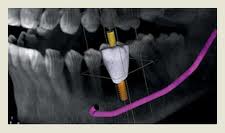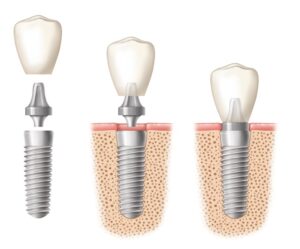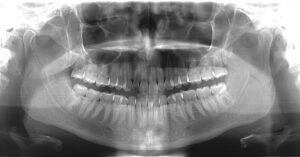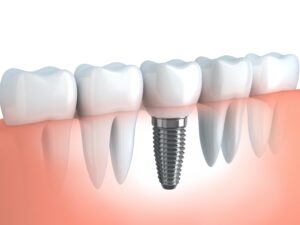Header logo
header top contact widget
Dentures/Partial Dentures
Dental Implants – Lower Risks Of Failure With These Tips
Posted on Apr 21, 2022 by William J. Claiborne, DDS MS
In our Asheville periodontal dental office, we believe our patients appreciate being fully informed about their oral health status and understanding their options for treatment. For those who have lost natural teeth, our specialty dental services include the diagnosis and placement of dental implants.
The specialized skills of a periodontist provides implant patients with a high level of success in treatment outcome. It also offers patients a wider variety of choices when it comes to implant systems.
This is why many general dentists who offer dental implants refer the placement portion to a periodontal specialist. For their patient, this can mean a higher level of success, especially for complex needs.
For example, a patient who is missing a lot of bone mass (often due to missing natural teeth for many years) benefits from the specialized skills of our Asheville periodontal office. Another example is a patient who has lost teeth due to periodontal (gum) disease. Because a periodontist combines advanced skills in treating gum disease as well as in dental implants, these patients are given a ‘leg up’ when it comes to treatment success.
In making your decision to opt for dental implants vs. crown-&-bridge, dentures or partials, it is important to understand the basics of how dental implants work. Although there are different types of implant systems, all work in in a similar fashion.
An implant is similar to a screw-like cylinder that is hollowed out in the center. This segment is what is placed into the bone to serve as a tooth root replacement.
Selecting the most appropriate type of implant and how many are needed is based on specific needs and goals. Our Western NC periodontal office plans for your placement procedure using computerized technology to determine the precise angles and depths for each implant before the placement procedure begins. This minimizes disruption to the gum tissues and bone structures, which in turn reduces healing time and optimizes comfort.
Once placed, each implant is covered over with gum tissue. For several months after, the implant goes through a process known as “osseo-integration.” During this phase, the bone grows around the implant, securing it into the bone. This recreates the foundation of natural tooth roots to give biting and chewing stability. Throughout this time, you can wear a denture or temporary so you are never without teeth.
Once healing is complete, a post is secured inside the hollow core of the implant. This post (or “abutment”) will support your final replacement tooth or teeth.
An important aspect of implant success also relies on the proper assessment of bone mass. When the upper or lower jaw has insufficient bone to support the implant being placed, there is a risk of failure.
Again, an implant requires careful selection and placement to be able to support the replacement teeth being attached. In some cases, as few as 4 – 6 implants can support a complete arch of teeth. This decision is best left in the hands of a periodontal specialist.
Severe bone loss can require bone rebuilding procedures prior to implant placement. This can be done by bone grafting or the application of a bone-rebuilding material. In some cases, dental implant systems designed with unique angles (such as the “All On 4”) can support a fulll arch of upper or lower teeth using minimal bone depth with no bone rebuilding necessary.
Another perk of the All On 4 is the forces of chewing and biting require only 4 implants on the upper and/or lower. Because implant costs are largely based on the number of implants placed, this can be a great savings for people who are candidates.
Why does successful placement rely so greatly on assessing bone mass? An implant must be placed in adequate bone that does not risk interfering with adjacent structures.
Without proper placement in sufficient bone, an implant risks coming in contact with a nerve that extends horizontally through the lower jaw. Upper implants placed too close to the sinus cavity can, over time, penetrate that area. Removing an implant in either of these situations, of course, is no simple task.
The ability to select the proper implant type for available bone depth is equally important.
Dental implant diagnosis and placement skills can vary greatly from one dentist to another. While some have taken extensive courses in implant dentistry, others may have taken a weekend course here and there. These are typically ‘hosted’ by a particular manufacturer who provides ‘training’ in a limited selection of implant types. In turn, this can limit the patient’s choices when relying on appropriate recommendations for his or her unique needs.
Obviously, a qualified doctor can enhance your potential for a successful outcome, which is where a periodontal specialist is a wise choice. A Periodontist has particular expertise in the diagnosis and placement of all types of Dental Implants. As a matter of fact, many general dentists prefer to have a Periodontist place implants in their patients. The patient then returns to their dentist for the attachment of teeth to the implants.
Rest assured – in our office, comfort is always a priority. For our patients, we offer oral or I.V sedation to accompany many procedures. While both are beneficial to calm anxiety, tension, stress or even intense feelings of fear, each has its advantages as well as limitations.
Oral sedation is in pill form and provides a fully relaxed state. It often erases most memory of the procedure after and has a quick recovery.
While oral sedation provides a very relaxed state, I.V. sedation puts you in a complete sleep state. This is sometimes referred to as “twilight sleep.” I.V. sedation is ideal for people with dental fear or phobia. This sedation is delivered through an I.V. drip, or intravenously. It takes effect rather quickly and patients nod off within minutes. This sedative erases memory of treatment afterward.
Whether given oral or I.V. sedation, comfort and safety are important to us at all times. And, while sedation is helpful when fear or anxiety exist, some people who have no fears at all request sedation for its ability to relax them during lengthy appointments.
While the doctor involved in your treatment is important, much of the potential for a successful result falls into the patient’s hands after the placement process. As a patient, having a successful outcome begins as soon as your implants are placed.
First, closely follow your post-placement instructions. For a few days following placement, most patients are advised to eat only cool, soft foods. This helps to minimize swelling and bleeding, which helps gum tissues to more quickly seal incision sites. This can lower your risk for infection.
Once home, other factors can also place your implants at risk. For example, smokers have a higher risk for implant failure. Because the chemicals in cigarette smoke are very drying to oral tissues, the healing process takes longer. Delayed healing creates a greater risk for infection to occur.
An element of risk that may surprise you is grinding or clenching teeth during sleep, which is typically a symptom of a misaligned bite. Some clenching is so intense the force can be likened to that used to crack a walnut. A sign of night-time clenching or grinding may be worn, chipped or broken teeth. However, even without signs, if you suspect you grind or clench, mention this to your implant dentist prior to treatment. This way, proactive measures can be taken to resolve the problem before complications result.
Most important of all is the patient’s commitment to maintaining good oral hygiene. Although Dental Implants themselves do not experience decay, the gum tissues and bone supporting the implants are as susceptible to oral bacteria as before. When oral bacteria infection (gum disease) penetrates to the implant site positions, the only way to treat the infection may require removing the implant.
In addition to being highly committed to your oral hygiene at home, your dental check-ups may be scheduled for every four months rather than twice a year. During these visits, a hygienist will remove accumulated oral bacteria to reduce risk to your Dental Implants. The condition of your gums will also be assessed.
Dental implants are designed to last a lifetime and are the closest thing to the natural teeth you once had. Too, the restored ability to bite, chew, speak and laugh without worry can be a tremendous boost to one’s self-esteem and self-confidence.
The type of dental implant best suited for you can be determined after an examination and review of x-rays (we use Cone-Beam digital imaging). Call 828-274-9440 to begin with a private, no obligation consultation to discuss your best options.
Some Amazing History & ‘Back Stories” of Dental Implants!
Posted on Mar 11, 2022 by William J. Claiborne, DDS MS
Some “baby boomers” may recall a popular television show, The Six Million Dollar Man. The series ran from 1973 to 1978, with Lee Majors playing the role of Steve Austin, a former astronaut. After a NASA test flight accident, Steve had been rebuilt with bionic implants that gave him a number of superhuman qualities.
When this aired over 40 years ago, it seemed so futuristic; yet today, bionic implants are rather commonplace. One of the reasons is through the refined use of titanium.
Titanium was discovered in Great Britain in 1791 and named after the Titans of Greek mythology. Titanium is 60 percent denser than aluminum, but more than twice as strong. Titanium is non-magnetic, resistant to corrosion and has a strength-to-density ratio that is the highest of any metallic element.
Titanium can be alloyed (combined with additional element(s), such as iron, aluminum, vanadium, and other elements. These combinations can produce strong, lightweight alloys for a vast number of uses. Titanium is used for jet engines, missiles, spacecraft, and in the military, automotive, agriculture (farming) industries. Titanium is often used in medical prostheses, orthopedic implants, dental instruments used in root canals, and dental implants. Other uses range from components in sporting goods (such as golf clubs), jewelry and mobile phones.
Because titanium alloys have a high crack resistance, they are used in aircraft, armor plating, naval ships, spacecraft, and missiles. About two-thirds of all titanium metal produced is used in aircraft engines and frames. Titanium is also used in nuclear waste storage.
Because titanium is resistant to corrosion by sea water, it is used to make propeller shafts, rigging, and heat exchangers in desalination plants; along with many other uses for salt water components. Titanium is used in the housings and components of ocean-deployed surveillance and monitoring devices for science and the military.
The human body has also been given the advantages of titanium as it is biocompatible (non-toxic and not rejected by the body). Titanium is often used in surgical instruments, such as those used in image-guided surgery, as well as wheelchairs, crutches, and any other products where high strength and low weight are desirable. Inside the body, titanium is common in surgical implements and implants, such as hip balls and sockets (joint replacement) and dental implants that can remain dependably positioned for decades.
For orthopedic implants, the use of titanium means that skeletal loads are more evenly shared between bone and implant. This lowers the potential for bone degradation due to stress, reducing the risk of bone fractures, which have a tendency to occur at the boundaries of orthopedic implants.
Patients with titanium implants can be safely examined with magnetic resonance imaging (MRI).
When you think of dental implants – or other implants-in-bone, such as knees, hip joints, etc. – titanium has the remarkable ability to osseointegrate. Osseointegration is a term used when an artificial implant is surgically anchored into bone, in which the bone then grows around the implant. This restores strength and stability to the bone that can offer a lifetime solution.
The bone in which an implant is placed also benefits from the presence of titanium. In the jaw bone, where natural tooth roots are missing, their absence leaves the bone mass without stimulation once provided by the tooth’s roots. This stimulation is what helps the bone to maintain its mass.
Once bone loss begins, the pace of bone shrinkage, known as resorption, accelerates over time. The declining bone mass soon begins to cause a number of problems, including a change in the way a denture or partial fits.
Additionally, losing jaw bone mass causes changes in facial appearance. It may first appear as deep wrinkling around the mouth and as the corners of the mouth begin to turn downward, even when smiling. Jowls form as facial muscles detach from the shrinking bone. Over time, the mouth begins to sink inward and the chin moves closer to the tip of the nose.
Placing a dental implant into the bone halts the process of resorption. It recreates the stimulation once provided by natural tooth roots. And, because of the strength and stability of the implanted portions, patients with dental implants can rely on eating the foods they love again, biting and chewing with confidence.
https://en.wikipedia.org/wiki/Titanium
Having teeth is important for a number of reasons (eating, speech, appearance), which has been recognized throughout history. The first evidence of dental implants is attributed to the Mayan population roughly around 600 AD where they excelled in utilizing pieces of shells as implants as a replacement for mandibular teeth. Radiographs of Mayan mandibles show compact bone formation around the implants. It has also been found that, around 800 AD, a stone implant was shaped and placed in the lower jaw in early Honduran culture.
In addition to being the first U.S. president, George Washington is famous for his “wooden” teeth. History reveals that Mr. Washington suffered from dental problems from his twenties on. As a matter of fact, in his First Inaugural Address speech in 1789, Washington had only a single remaining natural tooth. Over the years, he wore several sets of dentures, but none made of wood. These were fashioned out of materials that included ivory, gold, lead, and human teeth.
In a letter to Washington from dentist John Greenwood (who fabricated dentures for Washington), he pointed out the staining of the dentures, likely due to consumption of Port wine. Dr. Greenwood cited the staining was what gave the dentures a grained, wooden appearance.
https://www.mountvernon.org/library/digitalhistory/digital-encyclopedia/article/wooden-teeth-myth/
Today, most of the “teeth” portions (restorations) are made of porcelain. Porcelain provides the most natural look and feel of “real” teeth with a similar luminosity of that of natural teeth. Porcelain is also highly durable the most resistant to staining.
To clarify a “dental implant”, it is a term that sums up what is actually a combination of components. Dental implants are typically three segments – the implanted portion that is held in the jaw bone, a post (abutment) that is positioned inside the implant and extends above the gums, and the attached replacement teeth (restorations).
A periodontist has have three years of specialized training beyond dental school to make them experts on both soft and hard tissues. Thus, they have the ideal combination of experience and knowledge to make sure you get a dental implant solution that looks and feels like your own teeth.
Because many people have lost one or more teeth due to periodontal disease, periodontists are an ideal choice in helping restore the gums to a healthy state while determining the best type of dental implant, and then placing the implant at the proper angle and depth.
Additionally, a periodontist can perform pre-implant placement procedures, which may be needed in certain cases. These can include:
Sinus Augmentation – The upper back jaw has traditionally been one of the most difficult areas to successfully place dental implants due to insufficient bone quantity and quality and the close proximity to the sinus. Sinus augmentation can help correct this problem by raising the sinus floor and developing bone for the placement of dental implants.
Ridge Modification – Deformities in the upper or lower jaw can leave you with and inadequate amount of bone in which to place dental implants. To correct the problem, the gum is lifted away from the ridge to expose the void where bone is missing. The void is then filled with bone or bone substitute to build up the ridge. Ridge modification has been shown to greatly improve the jaw’s appearance and increase the chances of successful implants.
Once your dental implant(s) is in place, your periodontal specialist can create a plan to help you maintain healthy implants, particularly in the prevention of peri-implant disease.
Peri-implant diseases are inflammatory conditions affecting the soft and hard gum tissues around dental implants. Similar to a natural tooth, bacteria can build up on the base of the implant, below the gum line. Over time, the bacteria irritate the gum tissue, causing it to become inflamed, damaging the tissue and if not caught early, causing the bone structure below the implant to deteriorate.
The history of dental implants is interesting, yet, what people want is to have their smile back and to enjoy the function of “real” teeth. Although the back stories of dental implants are many, what is most important is that we restore your smile and help you enjoy it for your lifetime.
Begin with a consultation in our comfortable Asheville periodontal dental office. Here, we can discuss what may be best for your needs in a private setting. We can discuss comfort options (including sedation), and estimated costs and treatment time. Here, you will be respected and treated with the compassion we would want for ourselves and loved ones.
Call 828-274-9440 to begin. You’ll speak with a member of our staff who will be happy to assist you.
Ages 65 & Over: Stay More Socially Involved With A Healthy Smile.
Posted on Feb 09, 2022 by William J. Claiborne, DDS MS
Science has shown that the act of smiling gives a boost to our mood. Even a “fake” smile triggers endorphins (feel-good chemicals) in the brain to release, providing a bit of a “natural high.”
There are many things that make us smile. Time spent with friends, family, and social activity are helpful in keeping an individual active and involved, and hopefully smiling. Unfortunately, older adults are more prone to social isolation. This has proven to be unhealthy, mentally, physically and yes, even for the health of a smile.
Older adults are already at a disadvantage when it comes to having a healthy, full smile. Some estimates show that over one-quarter (26 percent) of adults ages 65 and older have 8 or less remaining natural teeth. About 17 percent in this same age category are missing all of their teeth.
On a positive note, total tooth loss (being “fully edentulous”) in the 65 or older category is decreasing. When comparing the 5-year periods of 1999–2004 to 2011–2016, it dropped by nearly 30 percent.
However, tooth loss comes with many frustrations, and even embarrassment. Many adults who wear dentures or partial dentures to replace missing teeth have similar complaints: sore spots on tender gum tissues, difficulty biting or chewing, slips while speaking or laughing, discomfort and the fear of embarrassment.
These frustrations often lead to (1) a change in diet; and (2) less social involvement. When certain foods become too difficult to chew properly, adults often alter their diet, opting for softer foods that dissolve easily in the mouth. Unfortunately, these foods typically lack in protein and fiber needed for good health.
Too, improper chewing is challenging to the digestive system. It is no wonder that denture wearers have more gastrointestinal problems and take more medications than people who still have their natural teeth.
Social isolation and loneliness have been linked to numerous measures of health and well-being. One interesting study focused specifically on the effects of social isolation and loneliness in relationship to oral health.
The Chinese Longitudinal Healthy Longevity Survey was conducted in three time segments: 2011-12, 2014 and 2018. The purpose of the study was to asssess the effects of social isolation and loneliness on the rate of tooth loss.
Data of the survey was evaluated, with nearly 4300 adults 65 and older who were participants in at least two of the time segments. The findings showed that, as tooth loss increased, so did social isolation. This study provided strong evidence that social isolation was associated with fewer remaining teeth and even accelerated the pace of tooth loss.
This problem is not just one of our current 65+ age group. According to the U.S. Census, the number of American adults aged 65 years or older is expected to reach 98 million by 2060, making up nearly one-quarter of the overall population. This means that a 30-year-old today will be well within this age group in less than 40 years.
Currently, the poorest oral health in Americans 65 and over are those who are economically disadvantaged, have no insurance, smoke, and in racial and ethnic minorities. Additional factors are being disabled, homebound, or who live in nursing homes. After retirement, some adults lose insurance benefits and find that Medicare does not cover routine dental care.
A high percentage of older adults also have periodontal (gum) disease, the nation’s leading cause of adult tooth loss. Nearly 68 percent of adults aged 65 years or older have some level of gum disease. While nearly 1 in 5 older adults have lost all of their teeth, total tooth loss is twice as prevalent for adults ages 75 and older compared with the 65-74 age group.
Aging also increases the likelihood of developing oral cancer. Oral and pharyngeal cancers are primarily diagnosed in older adults at a median age of 62 years. Gum disease also increases risks of chronic diseases including arthritis, diabetes, heart disease, and stroke.
All of these challenges are why a periodontist can be instrumental in the health and well-being of adults, especially those in the “older” age groups.
A periodontist is a dental specialist who receives 4 years of undergraduate training at a college or university and goes on to earn a dental doctorate. After 4 years of dental school, they further their education for another 3-4 years before completing stringent requirements for a specialty certification in periodontics.
A periodontist begins by accurately diagnosing the stage of gum disease present, or if it does exist. Many people are surprised by its presence since it can exist without obvious signs or symptoms.
From there, we develop a customized treatment plan based upon factors such as the patient’s current overall health, their diet, medications, whether they smoke or drink alcohol, and their age. We also discuss sedation options if dental fear is a concern.
Treatment recommendations are made based on what will effectively resolve existing problems without over-treating or under-treating. By restoring the patient to good oral health, we are able to help many avoid tooth loss and rid their mouths (and thus, their bodies) from an overload of oral bacteria.
Periodontists also specialize in the diagnosis and placement of dental implants. They are trained to understand all the intricate concepts involved in selecting the proper type of implant. Additionally, they are skilled at placing implants at proper depths and angles. As they oversee your “healing” time, periodontists are able to optimize your comfort and outcome.
When tooth loss begins, replacing that tooth with a dental implant is highly advised. Dental implants are designed to last a lifetime and restore biting and chewing comfort and stability. Additionally, the stimulation they provide to the jaw bone helps to halt bone loss.
This is because the implanted portion, held by the jaw bone, recreates the presence of the natural tooth roots you once had. While a denture or partial is positioned on top of the gum tissues, dental implants have the advantage of the jaw bone as their foundation, just as natural teeth.
For those who feel they are “too old” for dental implants, many of our implant patients are well into their 80’s or 90’s. Keep in mind that today’s adults are staying in the workplace longer, staying active in senior years, and living longer. Since 1950, Americans added over 11 years to average life expectancy, to age 79, according to 2019 statistics.
At every age, your smile reflects you, and should be a positive reflection throughout your lifetime. If you are experiencing tooth loss, let’s discuss halting the process during a consultation appointment in our comfortable Asheville periodontal dental office.
Call 828-274-9440 to schedule an appointment.
https://www.cdc.gov/oralhealth/basics/adult-oral-health/adult_older.htm
Replace Teeth With Dental Implants Makes Good Sense
Posted on Nov 16, 2021 by William J. Claiborne, DDS MS
There’s a reason your general dentist is so determined to help you keep your natural teeth. When he or she recommends a crown (‘cap’) on a tooth to prevent potential removal (at the time or in the future), it is because a lost tooth is problematic in many ways.
First, the portions of teeth you see above the gum line stay in stable position because of the roots that hold it. Tooth roots (think “legs”) are supported by the upper or lower jaw bone. Larger teeth may have four roots. Some of the smaller teeth have only one.
These roots are beneficial to the health of the jaw bones. Tooth roots are connected to the jaw bone by veins and nerves that run from the tooth’s interior and out the bottom of each root leg. These vessels carry blood to the bone while providing a sort of stimulation that helps the bone to maintain its mass.
Think of the stimulation that tooth roots provide to how you might muscle atrophy. We all know that muscles, not used, will shrink in mass. When the jaw bones are lacking stimulation by the tooth roots they’re designed to hold, bone mass begins to decline.
Bone loss is the reason for a long line of problems. When bone loss occurs next to an area where natural teeth are held, those teeth are most likely to be the next to be lost.
When bone loss begins, it accelerates with each passing year. And eventually, a shrinking jaw bone reveals itself in changes in facial appearance. Initially, there may be deep wrinkling around the mouth. The corners of the mouth turn downward. Jowls form and the chin becomes more pointed.
As bone loss becomes more severe, the mouth seems to sink into the face. The nose and chin get closer, giving a “granny look”. The thin jaw bone is also more vulnerable to breaks.
Bone loss is what causes a change in how partials and dentures fit. As the bone height declines, the denture or partial becomes less secure from the declining bone shape to which it was designed to fit. More-frequent applications of pastes and adhesives are needed. Relines help but only temporarily.
Teeth also serve to support neighboring teeth. Each tooth keeps the ones on either side and above (or below) in proper position. This supports the “bite” alignment. A misaligned bite (how upper teeth fit and interact with lower teeth) can result in teeth that become chipped, worn or fractured.
Bite misalignment can also lead to TMJ disorder. The TMJ are your jaw joints, which hinge the lower jaw to the skull. When a misaligned bite causes stress or strain on these joints, the result can be headaches, sore jaw joints, ear ringing, vertigo, difficulty opening the mouth fully, and sore muscles in the face, neck and shoulders.
The reason we advise replacing teeth with dental implants are many:
1). A dental implant recreates the presence of a natural tooth. It provides stimulation to the bone, halting the process of bone loss.
2). Dental implants do not rely on neighboring teeth for support, as in a crown-&-bridge combination. The crowning of bordering natural teeth to support a bridge is not needed. Thus, the integrity of surrounding teeth is protected.
3). Because dental implants are supported by the jaw bone, sturdy and dependable biting and chewing strength is restored. Eating a healthy diet of all the foods you love is again possible.
4). Dental implants come in many sizes and shapes, each system designed to accommodate various needs and preferences. This means your implant can be chosen to suit your long-term goals.
5). Dental implants have an extremely high success rate, higher than any implant-in-bone option.
6). Dental implants are designed to last a lifetime. With proper selection and maintenance, they will never need replacing or repair. This makes them an excellent investment.
A periodontist is a dental specialist who is skilled offers an advanced understanding when it comes to oral tissues as well as dental implants. The advantages of a periodontist in dental implant selection and placement are many.
A periodontal specialist is trained to understand the intricate concepts involved in selecting the proper type of implant and skilled at placing implants at proper depths and angles. A periodontist is also able to optimize patient comfort during treatment and throughout the healing phase.
Using his or her advanced training in the diagnosis and placement of dental implants, a periodontist can help you enjoy a higher potential for dental implant treatment that lasts a lifetime.
In our Asheville periodontal dental office, we offer some of the most advanced technology available. This technology, combined with our advanced skill level, can help you enjoy a comfortable, efficient experience that allows you to have optimal success.
To learn more, call our office at: 828-274-9440 to request a consultation. Or, begin with an initial periodontal examination.
Recent Posts
Categories
Archives
- September 2024
- August 2024
- July 2024
- June 2024
- May 2024
- April 2024
- March 2024
- February 2024
- January 2024
- December 2023
- November 2023
- October 2023
- September 2023
- August 2023
- July 2023
- June 2023
- May 2023
- April 2023
- March 2023
- February 2023
- January 2023
- December 2022
- November 2022
- October 2022
- September 2022
- August 2022
- July 2022
- June 2022
- May 2022
- April 2022
- March 2022
- February 2022
- January 2022
- December 2021
- November 2021
- October 2021
- September 2021
- August 2021
- July 2021
- June 2021
- May 2021
- April 2021
- March 2021
- February 2021
- January 2021
- December 2020
- November 2020
- October 2020
- September 2020
- August 2020
- July 2020
- June 2020
- May 2020
- April 2020
- March 2020
- February 2020
- January 2020
- December 2019
- November 2019
- October 2019
- September 2019
- August 2019
- July 2019
- June 2019
- May 2019
- April 2019
- March 2019
- February 2019
- January 2019
- December 2018
- November 2018
- October 2018
- September 2018
- August 2018
- July 2018
- June 2018
- May 2018
- April 2018
- March 2018
- February 2018
- January 2018
- December 2017
- November 2017
- October 2017
- September 2017
- August 2017
- July 2017
- June 2017
- May 2017
- April 2017
- March 2017
- February 2017
- January 2017
- December 2016
- November 2016
- October 2016
- September 2016
- August 2016
- July 2016
- June 2016
- May 2016
- April 2016
- March 2016
- February 2016
- January 2016
- December 2015
- November 2015
- October 2015
- September 2015
- August 2015
- July 2015
- June 2015
- May 2015
- April 2015
- March 2015
- February 2015
- January 2015
- December 2014
- November 2014
- October 2014
- September 2014
- August 2014
- July 2014
- June 2014
- May 2014
- April 2014
- March 2014
- February 2014
- January 2014
- December 2013
- November 2013
- October 2013
- September 2013
- August 2013
- July 2013
- June 2013
- May 2013
- April 2013
- March 2013
- February 2013
- January 2013
- December 2012
- November 2012
- October 2012
- September 2012
- August 2012
- July 2012
- June 2012


